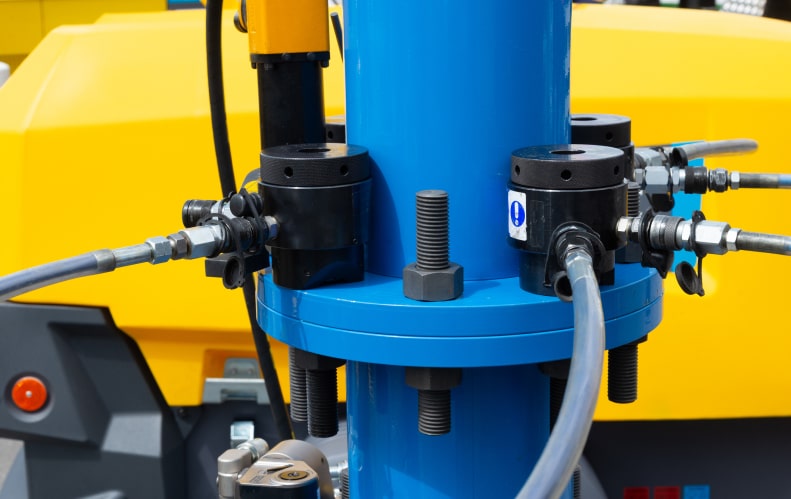In high-integrity industrial assemblies such as pipelines, pressure vessels, and flanged joints – ensuring consistent and accurate bolt preload is essential. One of the most precise and reliable ways to achieve this is through bolt elongation using hydraulic bolt tensioners.
At Petracarbon, a trusted engineering solutions provider based in Singapore, we regularly work with maintenance teams, engineers, and plant operators across Asia to deliver practical solutions that protect critical equipment. In this guide, we explore what bolt elongation is, why it matters, and how the right tools – like hydraulic bolt tensioners, flange alignment tools, and nut splitters – make precision assembly possible.

What Is Bolt Elongation and Why It Matters in Joint Integrity?
Bolt elongation refers to the axial stretch a bolt undergoes when tensioned. This stretch is directly related to the preload – the clamping force that holds flanged joints together. Maintaining accurate preload ensures a leak-free and structurally sound connection, especially under pressure and temperature cycling.
Torque ≠ Preload
Most conventional tightening uses torque to achieve preload. However, torque is heavily affected by friction on threads and under bolt heads, often resulting in inconsistent clamping force. That’s where hydraulic bolt tensioners come in – they apply pure axial force to stretch the bolt directly, giving far more reliable control over preload via elongation.
| Method | Accuracy | Affected by Friction? | Application |
| Torqueing | Moderate (±25%) | Yes | General bolting |
| Tensioning | High (±10% or better) | No | Precision joints, high-pressure systems |
How Hydraulic Bolt Tensioners Work to Control Elongation?
Hydraulic bolt tensioners are precision tools that apply direct tensile force to a bolt using a hydraulic cylinder. Once the bolt is stretched to a calculated elongation, the nut is rotated down to retain the tension before the load is released. This process allows for exact and uniform preload across all fasteners.
How Does It Work?
- A hydraulic bolt tensioner is fitted over the bolt.
- Hydraulic pressure is applied, stretching the bolt.
- The nut is hand-tightened while the bolt is stretched.
- The pressure is released, and the preload is maintained.
This method eliminates variables like thread lubrication, tool angle, and torque wrench calibration – making it ideal for critical flanged connections, such as those using flange alignment tools during assembly.
Learn more about this method in our previous post on Ensuring Precision with Hydraulic Bolt Tensioners and Torque Wrenches.
Measuring and Monitoring Bolt Elongation in the Field
Methods to Measure Elongation
| Method | Description | Pros | Limitations |
| Dial Gauge | Measures extension manually | Simple, direct | Limited to exposed bolts |
| Ultrasonic Gauge | Measures sound wave travel through bolt | Accurate, non-invasive | Requires calibration |
| Direct Measurement | Uses scribed lines or indicators | No tools needed | Low precision |
Calculating Bolt Elongation
To calculate how much a bolt should stretch, use:
ΔL = (F × L) / (A × E)
Where:
- F = Force applied
- L = Bolt length
- A = Cross-sectional area
- E = Young’s Modulus (material-specific)
Tool Synergy: Other Tools That Support Elongation-Based Assembly
Precision doesn’t happen in isolation. Proper bolt elongation requires alignment, safe disassembly, and high-quality fasteners. This is where supporting tools play a key role.
Flange Alignment Tools
Before any preload is applied, the flanges must be perfectly aligned. Misaligned flanges lead to uneven gasket compression, stress concentrations, and inaccurate elongation readings.
Flange alignment tools ensure parallel and rotational accuracy. Whether you’re working on an offshore riser or a high-pressure vessel, they’re essential for creating a stress-free environment before bolt tensioning.
Hydraulic Torque Wrench – When Space Is Tight
There are instances when hydraulic bolt tensioners cannot fit due to space constraints. In such cases, a hydraulic torque wrench is a suitable alternative. While less precise than tensioning, a calibrated torque wrench can still offer consistent tightening if elongation is monitored during tightening.
Using both torque and tensioning tools in hybrid configurations is becoming increasingly common in flange maintenance, especially when flange spreader tools and nut splitters are also involved.
Nut Splitter – The Safe Way to Remove Old Fasteners
One often overlooked part of bolt elongation control is removing old fasteners without damaging bolt threads or the flange. This is where a nut splitter becomes invaluable.
Rather than using cutting torches or grinders, which can damage the flange or stud, a nut splitter removes seized or corroded nuts cleanly – making the threads reusable and ensuring bolt elongation isn’t affected in future retensioning.
Flange Spreader Tool – For Inspection or Gasket Replacement
During inspection or maintenance, a flange spreader tool allows safe flange separation without damaging the flange face. This makes it easier to assess whether bolts have lost preload, inspect the gasket, or prepare for retightening using elongation targets.
Choosing the Right Tools for Elongation-Based Assembly
Not all applications require the same approach. Selecting the right equipment depends on bolt size, access, pressure class, and whether you’re working offshore, in a refinery, or in a clean-room manufacturing plant.
Here’s a helpful tool selection table:
| Application | Primary Tool | Support Tools |
| High-pressure flange (RTJ) | Hydraulic Bolt Tensioners | Flange Alignment Tool, Nut Splitter |
| Confined space flanges | Hydraulic Torque Wrench | Flange Spreader Tool |
| Routine maintenance | Torque or Tensioner | Flange Alignment, Nut Splitter |
| Emergency disassembly | Nut Splitter | Flange Spreader Tool |
Precision Starts with the Right Partner
Bolt elongation isn’t just a calculation – it’s a practice that protects lives, equipment, and uptime. When done right, it ensures your flanges seal perfectly, your bolts last longer, and your maintenance cycles are more predictable.
At Petracarbon, we offer a full range of hydraulic bolt tensioners, torque wrenches, nut splitters, and flange alignment and spreader tools – along with expert advice based on decades of field experience.
Visit Petracarbon to explore our full line of precision maintenance tools. Need expert support for your next shutdown or assembly? Contact Petracarbon to speak with an engineer.



